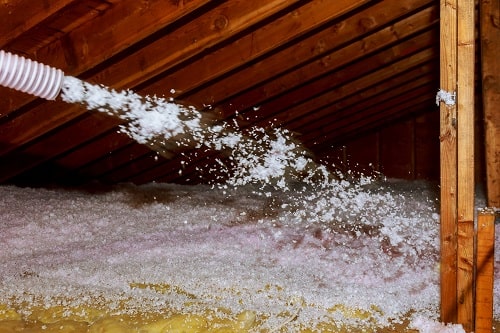Insulation is a key component of any household. It determines how comfortable the internal temperatures of your building will be. In addition, it more or less contributes to the amount of money you’ll pay for your energy bills. Due to this importance, many homeowners are installing insulation materials in their homes and commercial spaces.
Are you one of the homeowners who want to adopt insulation materials? With the many insulation materials available, how will you know the right one for you? Worry not; this is where this content feature comes in. It’ll discuss tips that’ll help you pinpoint the right type of insulation for your construction project. Follow on with the post for this insight.
As you make your choice of insulation material:
-
Consider The Surrounding Climate
The climate of the project’s location greatly determines the type of insulation to install in your home. This is concerning the amount of insulation you’ll need.
If the temperatures are cold for most of the year or it’s in an area surrounded by a forest, it’s best to add as much insulation as possible. This means you should insulate the walls, attic, basement, and other rooms in your home. On the other hand, if the climate is warm, you don’t need to add much insulation; one or two areas should suffice.
-
Work With A Professional
Your chosen contractor directly impacts whether you’ll choose the right insulation material or not. They’re experts in the field and need to advise you accordingly based on the type of your construction project.
A professional will tell you the advantages and disadvantages of each insulation material should you adopt it for your project. With this insight, you’re better placed in making your final decision. Make online search engines your friend to find out more about available professional contractors in your area.
The same can barely be said when you work with a contractor that’s not a professional. They’re likely to leave all the heavy work to you, where you might make mistakes in your choice due to the lack of know-how.
-
Check The R-Value
R-Value refers to the ability of an insulation material to resist heat transfer. In most cases, the composition of a material contributes to its ability to gain or lose heat. More or less, your choice of the R-value more or less depends on the energy efficiency you require in your space.
The higher the R-value, the less heat that’ll be lost through the material. This means you can maintain your home’s temperatures, in turn increasing energy efficiency. As you base your choice on the R-value, it’s good to note that it’s directly tied to the cost you’re going to pay.
-
Inquire About The Material’s Fire Rating
Fire is a major concern in any building; you want to minimize the possibility and spread of fire in any way possible to reduce associated damage. As a contractor, you want to use an insulation material that’ll limit a fire’s spread, should it happen. Different insulation materials have varying fire ratings, determined by their ability to reduce flame spread.
These ratings range from Class A to Class F. Under Class A, there are A1 and A2. A1 consists of the insulation materials that are completely fire resistant and won’t contribute to a fire, while A2 has a limited contribution. As you go down the classes, you’ll get to know more about each insulation option’s fire rating information.
It’s best to choose an insulation material that’s non-combustible, such as fiberglass, or one with the most limiting contributing factor.
-
Factor In the Location Of The Insulation
Location, in this context, refers to the area of the home you want to place the insulation. As previously stated, there are many areas you can decide to place your installation, such as the attic and walls. With the many types of insulations, each of which thrives differently in different conditions. For instance, a material can be good for indoor insulation but not perform outdoors, hence the need to factor in location.
Case in point, consider adopting injection spray foam if you’re to insulate a crawled space where access is an issue. Injection spray foam can easily get into tight spaces and fill the area up efficiently; it won’t leave any gaps. If it’s in an open area, such as internal walls, you can utilize fiberglass, or rock wool, which come as rolls.
It’s also essential to consider if the insulation will be external or internal. For external purposes, you need a strong material to withstand harsh environmental conditions without deteriorating in performance. Consider fiberglass or mineral wool with ultraviolet (UV) stability, unlike spray foam that shrinks with prolonged exposure to the sun.
-
Consider Sound Insulation
A given project might be based next to a road where there’s noise from vehicles passing by. Also, the neighborhood might be full of noisy activities, such as a nearby playground and many children. In such an environment, it’s advisable to choose an insulation material with sound-proof properties. One such material is fiberglass.
Alternatively, despite the material you choose, consider adding several layers as you install it. The layers will increase the volume and thickness of the material; any sound trying to pass through will be swallowed by the material.

-
Check For Allergenic Properties
Insulation materials are made from several components, some dangerous and others not. Nevertheless, the severity of the effects of these compositions depends on the individual. For instance, some people might experience a negative reaction to pollen, whereas others don’t experience anything from pollen exposure. The same concept applies to insulation materials.
An insulation material covers a big percentage of the building envelope, including some indoor spaces. This means you can’t ignore allergenic properties as a contractor, especially if your client has any respiratory conditions, such as asthma. Should you adopt a material, such as earth wool, its particles will alleviate the condition, which can be fatal, considering it’ll be a long-term exposure.
-
Factor In Moisture Resistance
Moisture in your home can wreak havoc, especially in enclosed areas. The areas can become room for fungi and mold growth, which can negatively affect your client’s health and deteriorate other household materials. Thus, to avoid harboring moist conditions, adopt non-hygroscopic insulation materials for they won’t absorb any moisture from the atmosphere.
Different insulation materials have varying installation techniques; some require a wet application, with others need dry application. To prevent moist conditions within your walls or in your attic, ensure you cure any material you use that requires wet application like cellulose. Preferably, make use of a moisture meter to check for any moisture in the material before covering it up; if present, air dry it or find an alternative technique.
-
Consider Costs
When deciding to invest in something, it all goes down to costs; can you afford it, even as you make all other considerations? The same applies as you choose the insulation material to adopt for your construction project.
Usually, the pricing of an insulation material is based on its performance characteristics, such as the R-value, and its manufacturer. A given company may sell fiberglass at price A, with another selling the same material with similar characteristics at price B. When you decide to base your purchase on the material’s manufacturer, consider choosing a reputable brand. There’s a very low possibility of a reputable brand conning you or selling you a substandard material.
As you consider costs, it’s best to look beyond the initial price. You need to factor in installation costs. Some vendors will include the installation fee in the initial price, while others require additional fees. With the additional fee situation, the ease of installation will determine the amount you’ll pay. If the insulation material requires a complex installation process, expect to pay more.
Besides the installation cost, you should also consider the availability of the material in your locality. If it isn’t readily available and you have to ship it, it’ll add to your costs.
Another factor that affects your long-term costs is the maintenance needs of your chosen insulation material. How often do you need to replace the material? Are you going to pay for maintenance services, or will the vendor do it for free?
Once you add all these short-term and long-term costs, you now need to compare the figure with your budget. Is the final cost within or beyond your budget? It’s always advisable to stick within your budget to avoid future financial hitches. A tip you can adopt before paying the amount is to ask for a discount; it’s always good to negotiate the amount you’re going to pay, no matter how small the percentage is.
Nevertheless, as you make the comparison, refrain from compromising quality for the price. It’s better to pay a high initial price and incur minimal to no costs in the future than pay less initially, and long-term costs become higher. In some situations, the long-term costs might exceed the initial price of your material, which is unfortunate; find a balance between the two.
Conclusion
This post has provided you with tips that you can adopt to ensure you settle for the right insulation material for your project. As seen, these tips are easy to follow; therefore, please implement them, and you won’t make the wrong decision.
As you adopt these strategies, you might wonder what factors to forego, especially when your desired material is lacking in a property discussed herein. In such a situation, let your needs be the guiding principle. If it’s the R-value, let it supersede the rest, even as you try and find a balance with the rest.




























